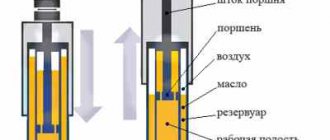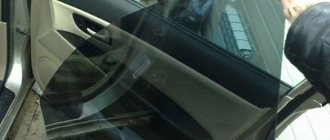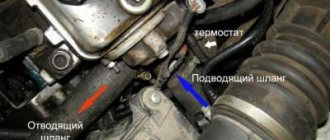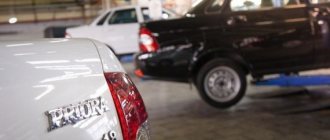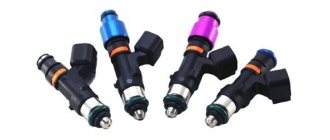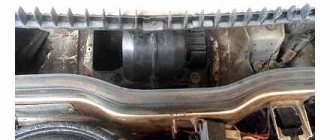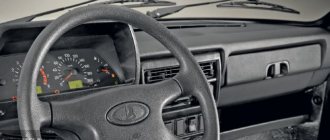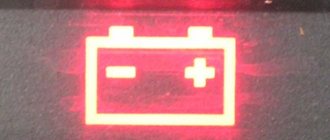Good afternoon, dear reader.
This article will consider the fine for not turning on low beam headlights , as well as fines for other violations of the rules for using lighting devices.
In 2021, all moving vehicles must have their lights on (daytime running lights, low beam headlights, or fog lights). Moreover, regardless of the time of day and visibility conditions.
Let's consider the fines for violating the rules for using lighting devices:
- How to avoid a fine for improper use of headlights?
- Fine for driving without lights during the day.
- Penalty for turning off headlights at night.
- Fine for driving high beams in the city.
- Penalty for turning on the fog light.
- Penalty for driving with one headlight.
Fine for driving without headlights at night
At night, drivers must turn on low or high beams in their cars.
High beams can be used on the highway to see the road in front of you, but you cannot:
- in populated areas with lighting lamps along the road;
- in front of another car that is moving in the opposite direction. According to the rules, high beams are turned off 150 meters before approaching, or earlier if the driver of an oncoming car blinks his headlights;
- when driving behind another car, so as not to blind the driver through the rear view mirror.
If your car is equipped with spotlights or searchlights, they can also be used only outside the city, when there are no oncoming cars.
If the car is parked on the side of the road at night, the driver must turn on the headlights and may additionally use other headlights.
Lighting devices - other features of use
Another type of automotive lighting is a spotlight or searchlight .
This is a device that produces a powerful and bright beam of light that can be directed in the desired direction. It is used only outside the city (especially off-road) and provided that there are no oncoming vehicles whose drivers may be temporarily blinded by the spotlight. In the city, such lighting equipment is used only by emergency vehicles. And for road trains, the rules provide for a special identification mark in the form of three orange lights on the roof of the vehicle cabin. When driving, it should always be on, and at night or when visibility is insufficient, the sign should also work during stops and parking.
There is also a “rule of good manners” that is not regulated in the traffic rules. If you drive past a traffic police post, a car accident or another unusual situation on the road, warn oncoming drivers by flashing your headlights.
It is also considered polite on the road not to use high beams and rear fog lights unless absolutely necessary - they shine too brightly and often blind other drivers. But these rules, unlike the previous one, are already enshrined in the traffic rules.
Video lesson: rules for using external lighting devices and sound signals.
How to avoid a fine for driving without headlights
Turn on the light immediately. The easiest way to avoid paying a fine for headlights is to get into the habit of turning on the low beam automatically as soon as you start the engine. With your headlights on, the inspector will have no reason to fine you.
The headlights do not work - turn on the fog lights. Daytime running lights or front fog lights can be used instead of low beams. This is also legal.
If caught, fix the problem immediately. If the inspector stopped you for unlit or dirty headlights, try to agree that you will correct the violation on the spot - turn on the lights or wipe the headlights. According to the law, a traffic police officer has the right to limit himself to a warning and not issue a fine.
What do the traffic rules say, are there any changes since June 6?
And the traffic rules still unambiguously and unconditionally establish in clause 19.5 that during daylight hours, drivers of any moving vehicles are required to use running lights or use low beam headlights to indicate their vehicle.
Below is a paragraph of the rules without distortion.
This means that you are required to drive with low beams or running lights at any time of the year during daylight hours, if the latter are provided for by the design of your car.
Alternatively, drivers can use fog lights in combination with low beam and running lights. Just don’t confuse the classic “dimensions” with running lights.
But where did the rumor about the abolition of low beam headlights come from?
Remember
- During the day, use low beams, running lights or front fog lights. At night - low or high beam.
- The high beam must be turned off on illuminated roads and when approaching other cars.
- The front fog lights can always be used, the rear ones can only be used when visibility is poor.
- The fine for not turning on headlights or incorrect use of lights on the road is 500 rubles.
- This fine can be paid at a discount in the first 20 days.
All articles by the author: Ilya Novikov
External lighting devices. Which of them can or should be used during the day?
LIGHTS.
Many citizens claim that drivers in the Russian Federation have begun replacing low beam headlights while driving during the day with side lights. A significant portion of Russians confuse side lights with daytime running lights (DRLs). DRLs only partially implement the function of side lights. Motorists may be fined when driving during daylight hours with only side lights on. And there will be no fine for driving with fog lights. Why? Let's find out...
DRL - daytime running lights.
DRLs in reality are often called side lights. In this case, they are confused with standard “dimensions” lights. Such confusion is unacceptable. Why? Side lights – indicate the front dimensions of the vehicle. DRLs differ from side lights in appearance and shape. As a rule, DRLs are in the form of an LED strip, which is built into the headlight unit. DRLs are perceived by the driver's eye earlier than side lights. Their light is brighter. But the DRL light does not illuminate the space in front of the car. DRLs consume less electricity. DRL is a safety element for a moving vehicle during the day.
The main task of DRL is to indicate a moving vehicle (vehicle) during the daytime. The creation of DRLs and their use as part of the external lighting devices of today's vehicles has eliminated the need to use low beam headlights during the day. LEDs require less electricity than halogen lamps. The DRL light is visible several hundred meters earlier than the low beam headlights.
Low beam headlights and DRLs.
In Europe, drivers were required to drive with low beams on during the day long before the same requirement was introduced in the Soviet Union. Presumably, they initially started driving with low beams in the daytime in the Scandinavian countries. In these countries, morning fog is commonplace. For the above reasons, later car manufacturers equipped the headlights with DRLs. From this point on, using low beams during daytime was no longer mandatory. Since the beginning of the second decade of the 21st century, car manufacturers in countries that have signed the Road Safety Convention.
The use of DRL in the Russian Federation is consolidated at the legislative level. So, according to clause 19.5. Traffic rules state that “during daylight hours, low beam headlights or daytime running lights must be turned on on all moving vehicles for the purpose of identifying them.”
As for the side lights, they must be turned on “when stopping and parking at night on unlit sections of roads, as well as in conditions of insufficient visibility” (clause 19.3. Traffic rules of the Russian Federation).
I hope readers understand that side lights are not included in this list of external lighting devices that must be used during the daytime. If the driver ignores the requirement of the Rules, Article 12.20 of the Code of Administrative Offenses of the Russian Federation (“Use of external lighting devices and sound signals”) may be applied to him. It provides for punishment in the form of a fine of 500 rubles.
What are the requirements of the Regulations regarding fog lights? The same section 19 of the traffic rules - clause 19.4 - says that fog lights can be used in conditions of insufficient visibility with low or high beam headlights, at night on unlit road sections together with low or high beam headlights, and also instead of low beam headlights in accordance with clause 19.5 of the Traffic Regulations.
RESULT.
During the day, the vehicle must have daytime running lights turned on while driving. If they are absent, low beam headlights or fog lights (without low beam or with it in conditions of poor visibility). It's simple!
Why do you need to turn on low beam headlights during the day?
The emergence of the requirement to turn on car headlights during the daytime was not an accidental phenomenon.
Car speeds have become much higher, and very often traffic flows along high-speed highways outside the city at speeds exceeding 100-120 km/h. The result is the need to maneuver a section 30-500 meters long. At such a distance, cars moving in the oncoming lane are distinguished quite poorly, especially on a sunny day, when glare emanates from the asphalt surface. In the presence of numerous bunnies from puddles, poles and other surfaces, it is quite difficult to distinguish one that belongs to an oncoming car.
The situation becomes even more unpleasant when the car is painted in a dark color. In this case, its body becomes almost invisible to the driver at a distance of 500 meters. The appearance of such invisible things on the road always occurs very suddenly and can cause a lot of unpleasant moments for drivers.
The worst way to see such cars without the lights on is when looking in the rearview mirrors. For example, a situation may occur when, when looking in the rear-view mirrors, the driver sees only gray asphalt, and begins to drive into oncoming traffic to overtake a truck. After this, a sound signal is usually heard, and the car driving behind begins to blink its high beams. It is his driver, who forgot to turn on the headlights, who is outraged by the fact that he was not noticed and was not allowed through. That is, turning on the headlights makes the car much more noticeable. Most headlights, regardless of type, make the car much more noticeable and even block the brightness of daylight. But many drivers do not consider it necessary to turn on the headlights, and limit themselves exclusively to side lights.
Dimensions are not the best option. In terms of brightness, side lights are much inferior to headlights. They are completely invisible from a great distance and they also do not improve the visibility of vehicles. In addition, the small side light bulbs become clearly visible only when the car is almost level with oncoming traffic, so there is practically no point in using them.
The reason for this behavior of drivers is hidden in taking an example from drivers of foreign countries, where it is not customary to drive during the day with headlights on. Instead, they include intricately shaped lights next to the headlights, which our drivers consider to be oversized. Accordingly, they also begin to use only side lights, until they receive clarification from the traffic police officer that such actions on the road do not make sense.
In fact, the lamps that turn on on the side of the headlights are not headlights, but daytime running lights (DRLs). In terms of brightness, they are comparable to low beam headlights, and are clearly distinguishable over a long distance. This was the reason for making changes to the traffic rules, which led to the consolidation of the use of DRL at the legislative level.
Consequences. For driving in the daytime without the headlights on, with only side lights, a fine of 500 rubles is provided, according to Article 12.20 of the Code of Administrative Offenses of the Russian Federation. In addition, it is prohibited to install daytime running lights on vehicles where their presence is not provided for by design.
Bottom line. During the daytime, car drivers must necessarily turn on low beam headlights or daytime running lights (if equipped). This will allow you to view the car from a great distance and prevent the creation of an emergency situation.
What devices are used at night?
It would be more correct, of course, to say “in the dark,” which is even defined in the traffic rules. Without going into too much detail, it’s just a time when it’s dark, at dusk in the morning or evening and at night.
Here headlights are used in high and low beam modes. If you are parked overnight (or if you are driving with a trailer, or are towed), then you need to switch to dimensions. In this case, the fog lights should not work separately; they are accompanied by high beam or low beam.
If you have a spotlight, do not use it if you are driving through a populated area or when you see an oncoming car. This is a traffic violation.
The rules establish a procedure that ensures the safety of all road users. Therefore, it is not allowed to blind oncoming drivers with high beams if the cars have approached more than 150 m. In addition, the oncoming driver may ask you to switch the mode of the lighting devices. This is usually done by “blinking” the headlights.
When moving around the territory of a well-lit populated area, they also do not use high beams. And, as in the situation with daytime mode, it is prohibited to use fog lights on a lit road without accompanying low or high beams. DRLs are also not turned on at night.
For movement through tunnels day and night, all of the above requirements apply.
Daytime running lights as an alternative
A good solution might be to install daytime running lights. But there are some nuances here too. New cars coming to the Russian market from Europe are already equipped with DRLs. Other cars that are already roaming the Russian expanses have to be equipped with DRLs independently and at their own expense in order to save a little on the costs described above and comply with traffic regulations. For your information, let us say that today in Russia the total number of cars equipped with daytime running lights is no more than 2.5%, in Ukraine no more than 1%.
At the same time, Russian legislation specifically on the issue of installing daytime running lights on vehicles turned out to be more humane than in Ukraine. Thus, the technical regulations provide for the installation of this type of lighting independently or at specialized service stations without subsequent re-registration of vehicles with the traffic police. The main thing is that the newly installed lighting equipment complies with the requirements of the technical regulations “On the safety of wheeled vehicles” paragraphs 6.19.1 - 6.19.9, approved by the Government of the Russian Federation on September 10, 2009, as well as GOST R 41.87-99 and UNECE rules No. 48 and No. 87.
In a nutshell, the main requirements boil down to the following parameters:
• DRL brightness should vary between 400 – 1200 candelas; • the color of the lamps must be exclusively white; • the distance between the edges of the two internal visible surfaces must be at least 60 cm; • devices should be located at a height of 25 to 150 cm above the road surface; • geometric visibility of the horizontal angle is 20°, vertical - 10°; • DRLs should turn on automatically when the engine starts, and turn off when the fog or low/high beam headlights are turned on, as well as when the ignition is turned off.
But since the very wording of the points of the technical regulations is somewhat blurred, and control over compliance with these same requirements is not strict enough, everyone began to interpret the concept of DRL in their own way. Some people embed diode bulbs directly into headlights, some install them in foglights, and some even manage to find a use for them in turn signals. By the way, not long ago we wrote about installing xenon, read here.
And the result is such a cacophony of light, in which it has now become difficult to distinguish where the column is, where the car is being towed, where the minibus is, where only one of the two lights is on. As for motorcycles and mopeds with their one single headlight, we will absolutely beg you, since they simply get lost in such a garland. And here, it seems, there is no time for safety...
Experience in implementing headlights on during the day
Thus, in Europe the rule “When you get behind the wheel, turn on the low beams” has existed for a long time (in Finland since the 70s). In most European countries, the decision to turn on or not turn on the low beam within the city is completely left to the discretion and conscience of the driver himself (outside populated areas, BS or DRLs must always be turned on). In addition, the installation of daytime running lights on vehicles not yet equipped with them is mandatory, but on preferential terms. And this suggests that European countries care not only about the safety of their citizens, but also about the size of their wallets. In the CIS countries the situation is somewhat different.
In Russia, to increase road safety, a law obliging drivers to turn on low beams (LS) or DRLs during daylight hours both outside and in the city has existed since 2010 (RF Government Decree No. 316). In Ukraine, it came into force only in April of this year and applies only to the autumn-winter period (from October 1 to May 1) and only when driving outside populated areas.
The result of this decision by the authorities was statistics according to which, according to reports from the Ministry of Internal Affairs, in 2011 the number of accidents in Russia actually decreased by 15%. But this is only one side of the coin. But there is another side...


